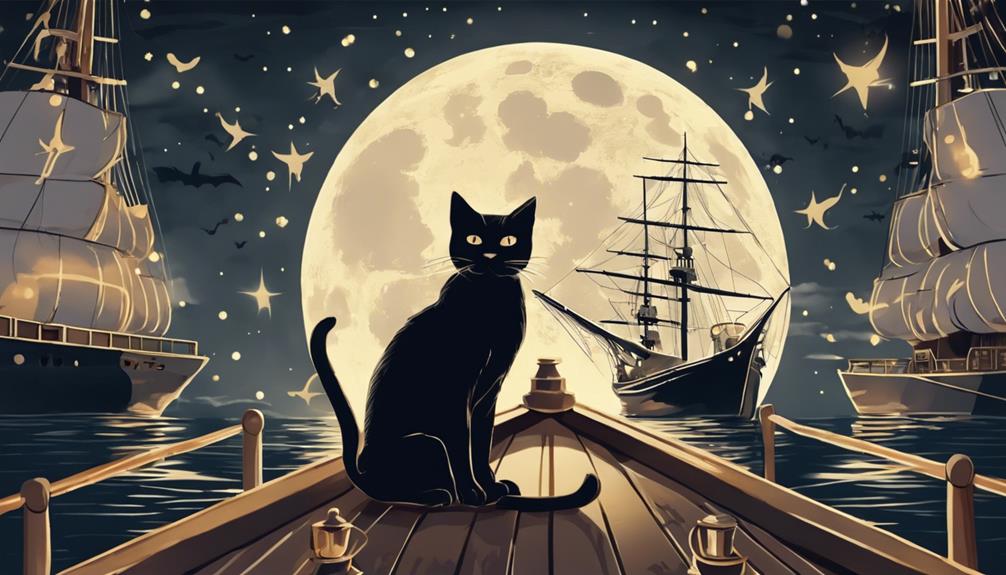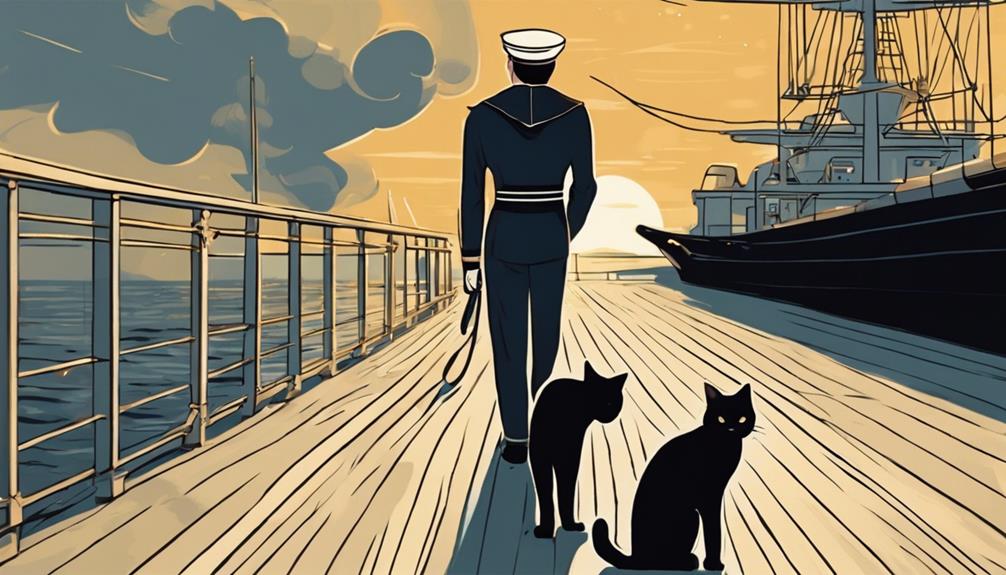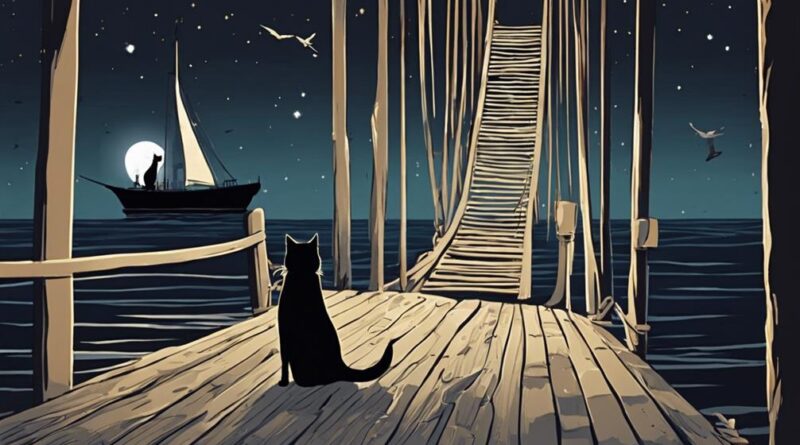10 Superstitions About Sailors and Black Cats Unveiled
Embark on the intriguing world of maritime superstitions and the special bond between sailors and black cats. Discover 10 deeply ingrained beliefs that influence seafaring traditions. From ancient rituals for safe voyages to the superstitions surrounding black cats, sailors' customs are rich in mystique. Learn about myths and rituals tied to black cats, redheads, burials at sea, and more. Unravel the origins and significance of these superstitions, shedding light on the intricate beliefs that have shaped maritime culture for centuries. Each superstition offers a glimpse into the fascinating and sometimes eerie world of sailors and their superstitions.
Origins of Sailor Superstitions
The origins of sailor superstitions can be traced back to ancient maritime traditions and beliefs that have been passed down through generations. Sailor rituals and historical beliefs play a significant role in shaping these superstitions that continue to intrigue and influence sailors to this day.
Sailors, known for their strong sense of tradition, have always held various rituals in high regard. These rituals were often performed to bring good luck, ward off evil spirits, or ensure a safe voyage. One such ritual involved placing a coin under the mast of a newly constructed ship to appease the gods of the sea and guarantee a successful journey. These practices were deeply ingrained in the maritime culture and were believed to protect sailors from harm.
Historical beliefs also played a crucial role in the development of sailor superstitions. Ancient sailors, faced with the vast unknown expanse of the ocean, often sought explanations for natural phenomena beyond their understanding. This led to the creation of myths and legends that influenced their behavior and decision-making. For example, the belief in mermaids luring sailors to their demise reinforced the idea of respecting the sea and its mysterious powers.
Black Cats on Shipboard
In maritime folklore, black cats aboard ships have long been associated with both good and bad luck, adding an air of mystery to seafaring superstitions. These feline companions have been a common sight on many vessels throughout history, sparking various beliefs and practices among sailors.
- Rat Catchers: Black cats were valued members of the crew for their exceptional hunting skills. Their presence helped control the rodent population on ships, preventing damage to food supplies and equipment.
- Superstitions of Luck: While some sailors believed that having a black cat on board brought good luck and protection from malevolent spirits, others thought it signified imminent danger or a storm approaching. The superstitions surrounding black cats were deeply ingrained in nautical culture.
- Symbol of Transformation: In certain seafaring traditions, black cats were seen as mystical creatures capable of shifting between the physical and spiritual realms. Sailors often viewed them as guardians with the power to guide ships safely through treacherous waters.
- Ceremonial Roles: Black cats were sometimes included in maritime rituals and ceremonies, where they were thought to bestow blessings upon the crew and ensure a prosperous voyage. Their mysterious aura added an element of reverence to these seafaring customs, highlighting the deep-rooted connection between sailors and their feline companions.
Luck and Feline Companions
Amidst the intricate web of maritime superstitions, the role of black cats as bearers of luck and companions to sailors emerges as a captivating and nuanced aspect of seafaring lore. Sailors have long held beliefs in the mystical powers of black cats, attributing them with the ability to bring good fortune and protect against harm while at sea. This deep-rooted connection between sailors and their feline companions is intertwined with centuries-old sailor folklore and observations of cat behavior on ships.
Sailor folklore often depicts black cats as wise and mysterious creatures that possess an innate understanding of the sea's unpredictable nature. Their agility, keen senses, and independent nature make them well-suited for maritime life. Sailors have observed how these cats navigate the swaying decks with grace, their eyes reflecting the moonlight as they roam the ship during the night watches. Such behaviors have led to the belief that black cats can perceive changes in the weather or detect supernatural entities that may bring misfortune.
Furthermore, black cats were seen as loyal companions to sailors, offering comfort and companionship during long and arduous voyages. Their presence on board was thought to not only bring luck but also to ward off evil spirits and ensure a safe journey. This bond between sailors and black cats symbolizes a deep connection between humanity and the animal world, transcending superstition to embody a sense of camaraderie and mutual respect on the open seas.
Portents of Misfortune
Navigating the realm of seafaring superstitions unveils a tapestry of beliefs surrounding black cats as harbingers of misfortune. While these beliefs have been ingrained in maritime lore for centuries, delving deeper reveals a more nuanced understanding of the superstitions that have surrounded sailors and black cats.
- Common Misconceptions: The common misconception that black cats bring bad luck to sailors stems from ancient beliefs that black cats were witches' familiars or even witches themselves in disguise. This association with witchcraft perpetuated the idea of black cats as omens of doom.
- Superstition Origins: The origins of the superstition surrounding black cats can be traced back to various cultures where they were seen as symbols of bad luck. Sailors, known for their superstitions, adopted these beliefs and incorporated them into their seafaring customs.
- Cultural Beliefs: Different cultures have varying beliefs about black cats, with some viewing them as bringers of good fortune. However, in the context of sailors and the sea, the prevailing belief has been one of trepidation and fear when encountering a black cat onboard.
- Misunderstood Customs: The customs surrounding black cats and sailors highlight the deeply ingrained superstitions prevalent in maritime history. These customs, although rooted in fear and caution, shed light on the intricate tapestry of beliefs that have shaped seafaring traditions.
The Myth of the One-Eyed Cat
A prevalent superstition among sailors revolves around the myth of the one-eyed cat, steeped in tales of mystery and foreboding. In maritime lore, the one-eyed cat is often seen as a symbol of impending doom, believed to bring bad luck and tragedy to those who encounter it. This superstition has deep historical roots, dating back to ancient seafaring traditions where sailors relied heavily on omens and signs to guide their journeys.
The one-eyed cat holds symbolic significance in the maritime world, representing a warning of dangers ahead and a signal to proceed with caution. Sailors would go to great lengths to avoid crossing paths with a one-eyed cat, as it was thought to herald shipwrecks, storms, or even death among the crew. This belief was so ingrained in nautical culture that sailors would often change course or delay voyages if they caught sight of a one-eyed feline on board or near the docks.
The myth of the one-eyed cat serves as a reminder of the unpredictable and treacherous nature of the sea, instilling a sense of respect and fear in those who brave the waters. While modern sailors may dismiss such superstitions as mere folklore, the historical context behind the myth continues to fascinate and intrigue, highlighting the enduring legacy of maritime beliefs and rituals.
Nautical Rituals and Beliefs
Sailors' beliefs and practices on the high seas are deeply intertwined with a rich tapestry of nautical rituals and superstitions that have endured through centuries of maritime history. These rituals and beliefs often serve as a source of comfort and guidance for sailors facing the unpredictable and often harsh conditions of the open ocean.
- Tattoos as Protective Symbols: Sailors often adorned themselves with tattoos not just for personal expression but also as protective symbols believed to bring luck and ward off evil spirits during their voyages. Images of anchors, swallows, and nautical stars were common choices, each carrying its own significance.
- Never Whistling: Whistling on a ship is considered bad luck as it was believed to summon strong winds that could be detrimental to the voyage. Sailors avoided whistling to prevent invoking unfavorable weather conditions.
- Fear of Redheads: Some sailors held a superstitious belief that having a redhead on board would bring bad luck. Redheads were thought to possess fiery tempers that could anger the sea, leading to storms and misfortune.
- Burial at Sea Rituals: Nautical traditions dictate specific rituals for burying deceased sailors at sea. These rituals are performed with solemnity and respect, ensuring the safe passage of the departed sailors to the afterlife while appeasing the spirits of the sea.
Cats as Harbingers of Good Luck

Cats have long been regarded as symbols of good luck among sailors, with their presence on board believed to bring protection and prosperity during voyages. The cat symbolism of fortune dates back centuries, intertwining with maritime lore to create a sense of security and good fortune for those at sea. Seafaring companions, these feline creatures weren't only kept for their pest control abilities but also for their perceived supernatural powers.
In the intricate web of maritime superstitions, cats were seen as valuable members of the crew. Sailors often believed that having a cat on board ensured a safe journey and a successful return home. These beliefs were so deeply ingrained that cats became a common sight on ships of various sizes and types, from trading vessels to naval warships.
The connection between cats and good luck extended beyond mere protection from bad omens. Sailors also viewed these animals as intuitive beings that could sense impending danger, storms, or even changes in weather patterns. Their behavior was closely monitored, with any unusual actions interpreted as signs to heed caution or prepare for challenges ahead.
Superstitions Across Cultures
Exploring superstitions across different cultures reveals a diverse tapestry of beliefs and practices that influence various aspects of daily life. Superstitions have played a significant role in shaping cultural identities and traditions worldwide. Let's delve into some key aspects of cross-cultural beliefs and their historical origins:
- Cross-Cultural Beliefs: Superstitions, such as the belief in lucky charms or the fear of certain numbers, are prevalent across diverse cultures. These beliefs often stem from ancient traditions and continue to influence people's behaviors and decisions today.
- Historical Origins: Many superstitions have deep historical roots, often originating from folklore, religious practices, or societal norms. For example, the superstition surrounding breaking mirrors bringing bad luck can be traced back to ancient Roman times when mirrors were believed to reflect one's soul.
- Cultural Influences: Different cultures have unique superstitions that reflect their values and beliefs. For instance, in some Asian cultures, the number four is considered unlucky due to its resemblance to the word for 'death,' while in Western cultures, Friday the 13th is often viewed as an unlucky day.
- Global Exchange: With increased globalization and cultural exchange, superstitions have also crossed borders, leading to the adoption of certain beliefs in different parts of the world. This interconnectedness has contributed to the evolution and adaptation of superstitions across various cultures.
Myths Vs. Reality

Delving into the realm of superstitions, it becomes crucial to distinguish between myths and reality to uncover the underlying truths behind these age-old beliefs. When it comes to sailors and black cats, folklore analysis and superstitious psychology shed light on the intricate web of beliefs that have been woven over time.
Folklore analysis reveals that the superstitions surrounding sailors and black cats have deep historical roots. Sailors, known for their seafaring adventures fraught with dangers, developed various beliefs to bring them luck and protect them from harm. Black cats, with their association to witches and the supernatural, became symbols of bad luck in maritime folklore. However, reality often paints a different picture. Superstition psychology suggests that these beliefs stemmed from a need for control and predictability in uncertain environments. The rituals and superstitions acted as coping mechanisms, providing sailors with a sense of security amidst the unpredictable nature of the sea.
In essence, the myths surrounding sailors and black cats reflect a blend of tradition, cultural influences, and psychological needs. While some may dismiss these superstitions as mere tales, delving deeper reveals the intricate interplay between human psychology and societal beliefs that have shaped our understanding of the world.
Sailors' Superstitions Debunked
Unraveling the intricate web of maritime superstitions, it becomes evident that many of the beliefs held by sailors surrounding black cats are rooted more in tradition and folklore than in tangible reality. While superstitions have long been a part of sailor traditions, it's essential to debunk some of the myths that have persisted over time.
Here are four key points to consider when examining sailors' superstitions:
- Sailor Traditions: Sailors have a rich history of superstitions stemming from a mix of seafaring practicalities and ancient beliefs. These traditions often served as a way to bring comfort and a sense of control in the unpredictable maritime environment.
- Superstition Origins: The origins of many sailor superstitions can be traced back to a lack of scientific knowledge and the need to explain mysterious phenomena at sea. Black cats, for example, were considered omens of bad luck due to their association with witches in ancient folklore.
- Evolution of Beliefs: Over time, as maritime technology advanced and superstitions were challenged by rational thinking, many of these beliefs lost their hold on sailors. Sailors began to rely more on navigational skills and meteorological understanding rather than superstitions.
- Legacy of Superstitions: Despite the decline in superstitions among modern sailors, many of these beliefs still persist as part of nautical lore and storytelling, adding a sense of mystique to seafaring traditions.
Frequently Asked Questions
Do Black Cats Bring Bad Luck to Sailors?
Black cat myths and sailor superstitions often intertwine in folklore. Sailors have long believed that encountering a black cat at sea brings bad luck, fearing impending danger or even shipwrecks. This superstition has been passed down for generations, shaping the way sailors view these feline creatures.
The idea of black cats as harbingers of misfortune continues to be a prominent belief among seafarers, adding an air of mystery and caution to their journeys.
Are There Specific Rituals Involving Black Cats at Sea?
When it comes to rituals involving black cats at sea, some sailors have followed traditions that involve cat companionship during their sea voyages.
Maritime folklore is rich with superstitions, and some sailors believe that having a black cat onboard can bring good luck and protect the ship from harm.
These rituals date back centuries, showcasing the deep connection between sailors, black cats, and the mysterious allure of the open sea.
How Do Sailors View One-Eyed Cats?
When it comes to one-eyed cats, sailors are known to have mixed feelings. In pirate folklore, these felines are often seen as omens of bad luck, while in seafaring beliefs, they can be viewed as symbols of resilience and survival.
Myths surrounding one-eyed cats vary widely, with some sailors avoiding them altogether and others embracing them as symbols of strength in the face of adversity on the open seas.
What Are Some Global Superstitions About Sailors and Cats?
When it comes to global superstitions about sailors and cats, there's a fascinating mix of cat symbolism and cultural beliefs intertwined with sailor folklore.
These myths have been debunked over time, revealing a blend of tales that once shrouded the relationship between sailors and feline companions.
From bringing good luck to being harbingers of bad omens, the superstitions surrounding sailors and cats have added layers of intrigue to maritime history.
Can Sailors Truly Debunk All Superstitions Surrounding Black Cats?
When it comes to sailors debunking superstitions surrounding black cats, it's not just about disproving myths. It's about challenging ingrained beliefs and superstitions that have been part of seafaring culture for centuries.
By actively addressing and dispelling these superstitions, sailors can help change perceptions and show that black cats aren't harbingers of bad luck.
Superstitions debunked, seafaring myths shattered — it's all about breaking free from old beliefs.
Conclusion
In conclusion, sailors and black cats have been intertwined in superstitions for centuries, with beliefs ranging from good luck to impending doom. While these myths may seem irrational to some, they've been deeply ingrained in maritime culture.
By exploring the origins and debunking some of these superstitions, we gain insight into the fascinating world of sailors and their intriguing beliefs surrounding feline companions.
Explore the myths, but remember, superstitions are just that – superstitions.
